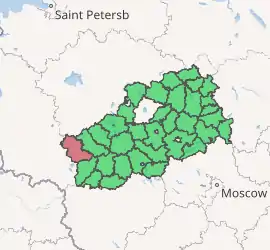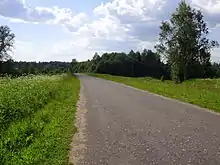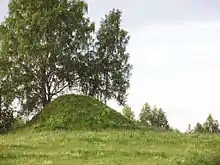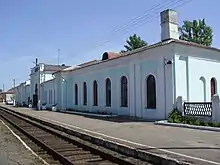Toropetsky District
Toropetsky District (Russian: Торо́пецкий райо́н) is an administrative[1] and municipal[6] district (raion), one of the thirty-six in Tver Oblast, Russia. It is located in the west of the oblast and borders with Kholmsky District of Novgorod Oblast in the north, Andreapolsky District in the east, Zapadnodvinsky District in the south, Kunyinsky District of Pskov Oblast in the southwest, Velikoluksky District of Pskov Oblast in the west, and with Loknyansky District of Pskov Oblast in the northwest. The area of the district is 3,373 square kilometers (1,302 sq mi).[2] Its administrative center is the town of Toropets.[1] Population: 20,526 (2010 Census);[3] 25,235 (2002 Census);[9] 31,228 (1989 Census).[10] The population of Toropets accounts for 63.4% of the district's total population.[3]
Toropetsky District
Торопецкий район | |
|---|---|
.png.webp) Flag .png.webp) Coat of arms | |

Location of Toropetsky District in Tver Oblast | |
| Coordinates: 56°30′N 31°38′E | |
| Country | Russia |
| Federal subject | Tver Oblast[1] |
| Established | 1927 |
| Administrative center | Toropets[1] |
| Area | |
| • Total | 3,373 km2 (1,302 sq mi) |
| Population | |
| • Total | 20,526 |
| • Estimate (2018)[4] | 18,218 (−11.2%) |
| • Density | 6.1/km2 (16/sq mi) |
| • Urban | 63.4% |
| • Rural | 36.6% |
| Administrative structure | |
| • Administrative divisions | 1 Urban settlements, 8 Rural settlements |
| • Inhabited localities[5] | 1 Cities/towns, 304 Rural localities |
| Municipal structure | |
| • Municipally incorporated as | Toropetsky Municipal District[6] |
| • Municipal divisions[7] | 1 Urban settlements, 8 Rural settlements |
| Time zone | UTC+3 (MSK |
| OKTMO ID | 28655000 |
| Website | http://toropecadm.ru/ |
Geography

The area of the district is divided between the drainage basins of the Kunya River (a tributary of the Lovat River) and the Daugava River, known in Russia as the Western Dvina. It thus fully belongs to the drainage basin of the Baltic Sea. The rivers in the northern part of the district flow to the Kunya, which itself crosses the district. The principal tributaries of the Kunya within the district are the Oka and the Serezha (both right). The Western Dvina makes a stretch of the border with Zapadnodvinsky District; the biggest tributary within the district is the Toropa (right). Toropetsky District also contains the western part of the lake district south of the Valdai Hills. The biggest lakes within the district are Lake Kudinskoye and Lake Solomennoye.
History

Presumably in 1167, Toropets became the center of the Principality of Toropets, which was subordinate to the Principality of Smolensk. The first prince of Toropets was Mstislav the Brave.[11] In the 14th century, the area joined the Grand Duchy of Lithuania, and in the 16th century (most notably, after the Battle of Vedrosha, 1503) it moved to the Grand Duchy of Moscow. In the course of the administrative reform carried out in 1708 by Peter the Great, the area was included into Ingermanland Governorate (known since 1710 as Saint Petersburg Governorate). In 1727, separate Novgorod Governorate was split off. Toropets was included into Velikiye Luki Province.[12] In 1772, as a result of the First Partition of Poland, Inflanty Voivodeship and eastern Belarus were transferred to Russia. In order to accommodate these areas, Pskov Governorate was created, and Velikiye Luki was transferred to Pskov Governorate. The town of Opochka was made the administrative center of the governorate. Pskov Governorate has proven to be too big to be administered properly, and in 1776, the decree of the empress, Catherine the Great, was issued. It divided the governorate into Pskov and Polotsk Governorates. Pskov was made the administrative center of Pskov Governorate, and the area remained in Pskov Governorate. In 1777, Pskov Governorate was transformed into Pskov Viceroyalty, which was administered from Novgorod by Jacob Sievers. In 1796, the viceroyalty was abolished, and on 31 December 1796 the emperor Paul I issued a decree restoring Pskov Governorate.[13] The area belonged to Toropetsky Uyezd of Pskov Governorate.
On August 1, 1927 Pskov Governorate was abolished, and Leningrad Oblast was established. Toropetsky Uyezd was abolished as well, and Toropetsky District, with the administrative center in Toropets, was established. It belonged to Velikiye Luki Okrug of Leningrad Oblast. On June 17, 1929, the district was transferred to Western Oblast. On August 1, 1930 the okrugs were abolished, and the districts were subordinated directly to the oblast. On January 29, 1935 Kalinin Oblast was established, and Toropetsky District was transferred to Kalinin Oblast.[14][15] Between Autumn 1941 and Winter 1942, during World War II, the district was occupied by German troops. On August 22, 1944, the district was transferred to newly established Velikiye Luki Oblast. On October 2, 1957, Velikiye Luki Oblast was abolished, and Toropetssky District was transferred back to Kalinin Oblast. In 1990, Kalinin Oblast was renamed Tver Oblast.[15]
On August 1, 1927 Bologovsky District with the administrative center located in the selo of Bologovo was established as well. The district was a part of Velikiye Luki Okrug of Leningrad Oblast, and on June 17, 1929 with the rest of the okrug it was transferred to Western Oblast. On September 20, 1930 the district was abolished and split between Kholmsky and Leninsky Districts.[15]
On June 1, 1936 Seryozhinsky District with the administrative center located in the selo of Bologovo was established. The district was a part of Kalinin Oblast. On August 23, 1944 it was transferred to Velikiye Luki Oblast, and on October 2, 1957 it was transferred back to Kalinin Oblast. On January 12, 1960 Seryozhinsky District was abolished and split between Leninsky and Toropetsky Districts.[15]
Another district established on June 1, 1936 was Ploskoshsky District with the administrative center located in the selo of Ploskosh was established. The district was a part of Kalinin Oblast. On August 23, 1944 it was transferred to Velikiye Luki Oblast, and on October 2, 1957 it was transferred back to Pskov Oblast. On July 29, 1958 the district was transferred from Pskov to Kalinin oblast. On January 12, 1960 Ploskoshsky District was abolished and merged Toropetsky District.[15]
In February 1963, during the abortive administrative reform by Nikita Khrushchev, Leninsky District was merged into Toropetsky District. On January 12, 1965 Andreapolsky District was established in the areas which previously belonged to Toropetsky and Ostashkovsky Districts.[15]
Economy
Industry
There are enterprises of chemical, metallurgical, textile, and food industries, most of which are located in Toropets.[16]
Agriculture
The main agricultural specialization of the district is cattle breeding with meat and milk production. There are also farms producing pork, as well as one farm raising weasels and sables for fur.[17]
Transportation

The railway connecting Bologoye with Velikiye Luki crosses the district from east to west. Toropets is the main railway station within the district. There is infrequent passenger traffic.
The M9 highway connecting Moscow with Riga also crosses the southern part of the district. A paved road branches off from M9, running via Toropets to Kholm and further to Staraya Russa.
Culture and recreation
_%D0%B2_%D0%A2%D0%BE%D1%80%D0%BE%D0%BF%D1%86%D0%B5.jpg.webp)
The district contains 98 cultural heritage monuments of federal significance (66 of them in Toropets) and additionally 68 objects classified as cultural and historical heritage of local significance (30 of them in Toropets). The federal monuments include plenty of buildings in the historical center of Toropets, as well as the Ascencion Church in the village of Baranets (19th century), the Dormition Church in the selo of Dopsho (1771), the Saint Nicholas Church in the selo of Metlino (18th century), the Saint Demetrius Church in the village of Nishevitsy (1765), the wooden Intercession Church in the selo of Pokrovskoye (19th century) as well as the ensembles of former estates in the selos of Mikhaylovskoye, Podgorodneye, Khvorostyevo, Chistoye, and Znamenskoye, and a number of archaeological monuments.[18]
There are a number of museums in the district, which include the Toropets District Museum, the Museum of the History of Photography, the house-museum of Patriarch Tikhon (Tikhon, in the future the Patriarch of the Russian Orthodox Church, lived here as a child for ten years), all of them are located in Toropets. In the selo of Volok, there is a museum of Elizaveta Dmitriyeva-Tomanovskaya, a feminist and a secretary of Karl Marx.[19]
References
Notes
- Государственный комитет Российской Федерации по статистике. Комитет Российской Федерации по стандартизации, метрологии и сертификации. №ОК 019-95 1 января 1997 г. «Общероссийский классификатор объектов административно-территориального деления. Код 28 255», в ред. изменения №278/2015 от 1 января 2016 г.. (State Statistics Committee of the Russian Federation. Committee of the Russian Federation on Standardization, Metrology, and Certification. #OK 019-95 January 1, 1997 Russian Classification of Objects of Administrative Division (OKATO). Code 28 255, as amended by the Amendment #278/2015 of January 1, 2016. ).
- "Торопецкий район" (in Russian). Legislative Assembly of Tver Oblast. Archived from the original on March 5, 2016. Retrieved January 4, 2016.
- Russian Federal State Statistics Service (2011). "Всероссийская перепись населения 2010 года. Том 1" [2010 All-Russian Population Census, vol. 1]. Всероссийская перепись населения 2010 года [2010 All-Russia Population Census] (in Russian). Federal State Statistics Service.
- "26. Численность постоянного населения Российской Федерации по муниципальным образованиям на 1 января 2018 года". Federal State Statistics Service. Retrieved January 23, 2019.
- Law #34-ZO stipulates that the borders of the administrative divisions of the district match those of the municipal formations the corresponding municipal district is subdivided into. Law #50-ZO contains the list of the municipal formations of Toropetsky Municipal District. The counts of inhabited localities are per OKATO.
- Law #4-ZO
- Law #50-ZO
- "Об исчислении времени". Официальный интернет-портал правовой информации (in Russian). June 3, 2011. Retrieved January 19, 2019.
- Russian Federal State Statistics Service (May 21, 2004). "Численность населения России, субъектов Российской Федерации в составе федеральных округов, районов, городских поселений, сельских населённых пунктов – районных центров и сельских населённых пунктов с населением 3 тысячи и более человек" [Population of Russia, Its Federal Districts, Federal Subjects, Districts, Urban Localities, Rural Localities—Administrative Centers, and Rural Localities with Population of Over 3,000] (XLS). Всероссийская перепись населения 2002 года [All-Russia Population Census of 2002] (in Russian).
- "Всесоюзная перепись населения 1989 г. Численность наличного населения союзных и автономных республик, автономных областей и округов, краёв, областей, районов, городских поселений и сёл-райцентров" [All Union Population Census of 1989: Present Population of Union and Autonomous Republics, Autonomous Oblasts and Okrugs, Krais, Oblasts, Districts, Urban Settlements, and Villages Serving as District Administrative Centers]. Всесоюзная перепись населения 1989 года [All-Union Population Census of 1989] (in Russian). Институт демографии Национального исследовательского университета: Высшая школа экономики [Institute of Demography at the National Research University: Higher School of Economics]. 1989 – via Demoscope Weekly.
- "Краткая историческая справка" (in Russian). Toropetsky District Administration. Retrieved January 14, 2016.
- Снытко, О.В.; et al. (2009). С.Д. Трифонов; Т.Б. Чуйкова; Л.В. Федина; А.Э. Дубоносова (eds.). Административно-территориальное деление Новгородской губернии и области 1727–1995 гг. Справочник (PDF) (in Russian). Saint Petersburg. p. 16. Retrieved February 4, 2012.
- "Псковская губерния" (in Russian). Руниверс. Retrieved January 15, 2016.
- Воробьёв, М. В. (1993). Г. В. Туфанова (ed.). Административно-территориальное деление Смоленской области (in Russian). Государственный архив Смоленской области. pp. 118–133.
- Справка об изменениях в административно-территориальном делении Тверской губернии - Калининской области (in Russian). Архивы России. Archived from the original on April 19, 2012. Retrieved December 5, 2014.
- "Промышленность Торопецкого района" (in Russian). Toropetsky District Administration. Retrieved January 13, 2016.
- "Сельское хозяйство" (in Russian). Toropetsky District Administration. Retrieved January 14, 2016.
- Памятники истории и культуры народов Российской Федерации (in Russian). Russian Ministry of Culture. Retrieved June 2, 2016.
- "Музеи Торопца" (in Russian). Город Торопец. Retrieved January 14, 2016.
Sources
- Законодательное Собрание Тверской области. Закон №34-ЗО от 17 апреля 2006 г. «Об административно-территориальном устройстве Тверской области», в ред. Закона №66-ЗО от 1 октября 2014 г. «О внесении изменения в статью 18 Закона Тверской области "Об административно-территориальном устройстве Тверской области"». Вступил в силу со дня официального опубликования. Опубликован: "Тверские ведомости", №17 (специальный выпуск), 19 апреля 2006 г. (Legislative Assembly of Tver Oblast. Law #34-ZO of April 17, 2006 On the Administrative-Territorial Structure of Tver Oblast, as amended by the Law #66-ZO of October 1, 2014 On Amending Article 18 of the Law of Tver Oblast "On the Administrative-Territorial Structure of Tver Oblast". Effective as of the official publication date.).
- Законодательное Собрание Тверской области. Закон №4-ЗО от 18 января 2005 г. «Об установлении границ муниципальных образований Тверской области и наделении их статусом городских округов, муниципальных районов», в ред. Закона №65-ЗО от 24 июля 2012 г. «О внесении изменения в статью 2 Закона Тверской области "Об установлении границ муниципальных образований Тверской области и наделении их статусом городских округов, муниципальных районов"». Вступил в силу через десять дней после официального опубликования. Опубликован: "Тверские ведомости", №3, 21–27 января 2005 г. (Legislative Assembly of Tver Oblast. Law #4-ZO of January 18, 2005 On Establishing the Borders of the Municipal Formations of Tver Oblast and on Granting Them the Status of Urban Okrugs, Municipal Districts, as amended by the Law #65-ZO of July 24, 2012 On Amending Article 2 of the Law of Tver Oblast "On Establishing the Borders of the Municipal Formations of Tver Oblast and on Granting Them the Status of Urban Okrugs, Municipal Districts". Effective as of the day which is ten days after the official publication.).
- Законодательное Собрание Тверской области. Закон №50-ЗО от 28 февраля 2005 г. «Об установлении границ муниципальных образований, входящих в состав территории муниципального образования Тверской области "Торопецкий район", и наделении их статусом городского, сельского поселения», в ред. Закона №20-ОЗ от 28 марта 2013 г. «О преобразовании муниципальных образований Торопецкого района Тверской области и внесении изменений в Закон Тверской области "Об установлении границ муниципальных образований, входящих в состав территории муниципального образования Тверской области "Торопецкий район", и наделении их статусом городского, сельского поселения"». Вступил в силу со дня официального опубликования. Опубликован: "Тверские ведомости", №10, 11–17 марта 2005 г. (Legislative Assembly of Tver Oblast. Law #50-ZO of February 28, 2005 On Establishing the Borders of the Municipal Formations Which the Territory of the Municipal Formation of "Toropetsky District" Comprises and on Granting Them the Status of Urban, Rural Settlements, as amended by the Law #20-OZ of March 28, 2013 On the Transformation of the Municipal Formations of Toropetsky District of Tver Oblast and on Amending the Law of Tver Oblast "On Establishing the Borders of the Municipal Formations Which the Territory of the Municipal Formation of "Toropetsky District" Comprises and on Granting Them the Status of Urban, Rural Settlements". Effective as of the day of the official publication.).